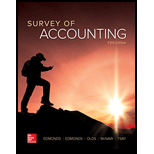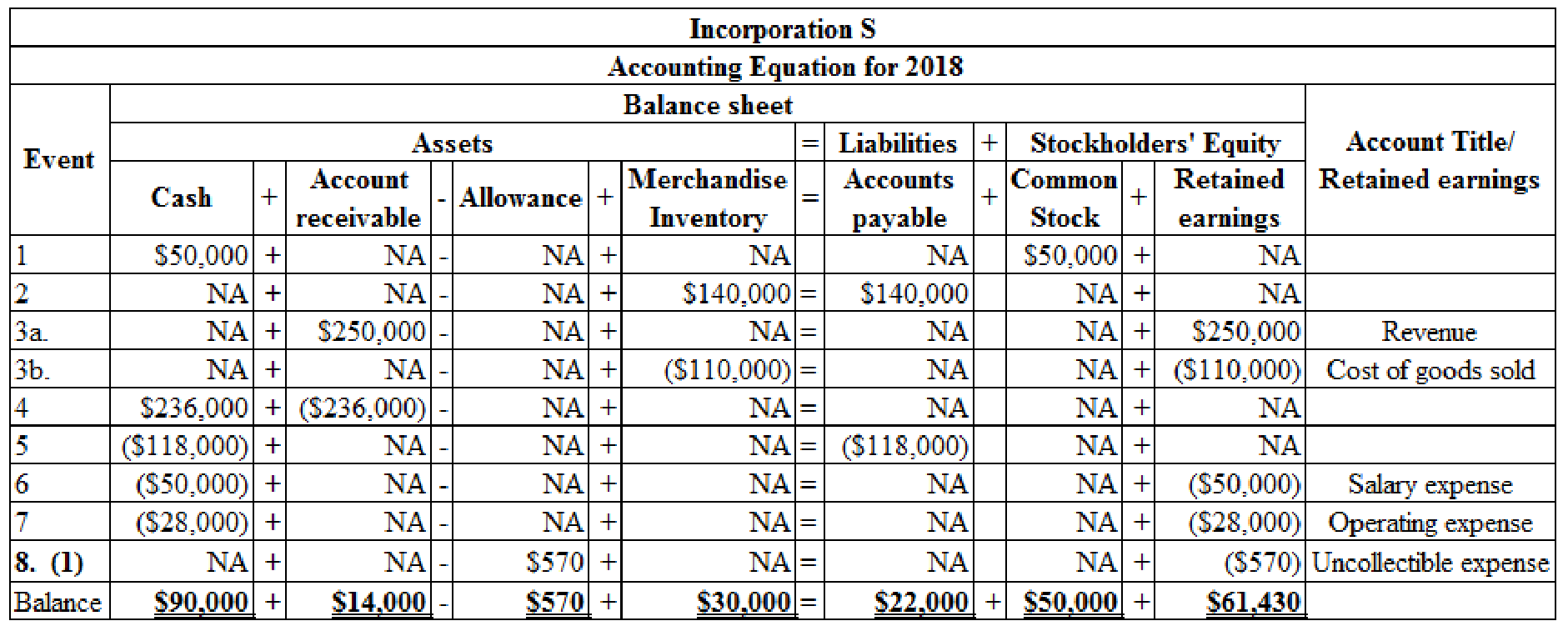
Concept explainers
Sage Inc. experienced the following transactions for 2018, its first year of operations:
- 1. Issued common stock for $50,000 cash.
- 2. Purchased $140,000 of merchandise on account.
- 3. Sold merchandise that cost $110,000 for $250,000 on account.
- 4. Collected $236,000 cash from
accounts receivable . - 5. Paid $118,000 on accounts payable.
- 6. Paid $50,000 of salaries expense for the year.
- 7. Paid other operating expenses of $28,000.
- 8. Sage adjusted the accounts using the following information from an accounts receivable aging schedule:

Required
- a. Organize the transaction data in accounts under an
accounting equation. - b. Prepare the income statement, statement of changes in stockholders’ equity,
balance sheet , and statement ofcash flows for Sage Inc. for 2018. - c. What is the net realizable value of the accounts receivable at December 31, 2018?
a)
Organize the transaction data in accounts under an accounting equation.
Explanation of Solution
Aging of receivables method: A method of determining the estimated uncollectible receivables, based on the age of individual accounts receivable is known as aging of receivables method. Under this method estimated bad debts would be treated as a target allowance balance.
Accounting equation: Accounting equation is an accounting tool expressed in the form of equation, by creating a relation between resources or assets of a business and claims on the resources by the creditors, and the owners.
The transaction data in accounts under an accounting equation is organized as follows:

Table (1)
Working note:
(1) Calculate the amount of uncollectible accounts expense:
| Number of days past due |
Amount | Percent Likely to be Uncollectible | Allowance Balance |
| (A) | (B) | (C) | |
| Current | $10,000 | .01 | $100 |
| 0-30 | $$2,000 | .05 | $100 |
| 31-60 | $1,200 | .10 | $120 |
| 61-90 | $500 | .20 | $100 |
| Over 90 days | $300 | .50 | $150 |
| Total | $570 |
Table (2)
b)
Prepare the income statement, statement of changes in stockholders’ equity, balance sheet and statement of cash flows for2018.
Explanation of Solution
Income statement: The financial statement which reports revenues and expenses from business operations and the result of those operations as net income or net loss for a particular time period is referred to as income statement.
Prepare the income statement.
| Incorporation S | ||
| Income statement | ||
| For the year ended December 31, 2018 | ||
| Particulars | Amount | Amount |
| Revenue | ||
| Sales revenue | $250,000 | |
| Total revenues | $250,000 | |
| Less: Expenses | ||
| Operating expense | $28,000 | |
| Salaries expense | $50,000 | |
| Uncollectible accounts expense | $570 | |
| Total expenses | ($78,570) | |
| Net income | $61,430 | |
Table (3)
Statement of changes in the stockholders’ equity: This statement reflects whether the components of stockholders’ equity have increased or decreased during the period.
Prepare the statement of changes in stockholders’ equity.
| Incorporation S | ||
| Statement of changes in stockholders’ equity | ||
| For the year ended December 31, 2018 | ||
| Particulars | Amount | Amount |
| Beginning common stock | $0 | |
| Add: Common stocks issued | $50,000 | |
| Ending common stock | $50,000 | |
| Beginning retained earnings | $0 | |
| Add: Net income | $61,430 | |
| Less: Dividends | $0 | |
| Ending retained earnings | $61,430 | |
| Total stockholders’ equity | $111,430 | |
Table (4)
Balance sheet: Balance Sheet is one of the financial statements that summarize the assets, the liabilities, and the Shareholder’s equity of a company at a given date. It is also known as the statement of financial status of the business.
Prepare the balance sheet.
| Incorporation S | ||
| Balance sheet | ||
| As of 31 December, 2018 | ||
| Particulars | Amount | Amount |
| Assets | ||
| Cash | $90,000 | |
| Accounts receivable | $14,000 | |
| Less: Allowance for doubtful accounts | $570 | $13,430 |
| Merchandise inventory | $30,000 | |
| Total assets | $133,430 | |
| Liabilities | ||
| Accounts payable | $22,000 | |
| Total liabilities | $22,000 | |
| Stockholders’ equity | ||
| Common stock | $50,000 | |
| Retained earnings | $61,430 | |
| Total stockholders' equity | $111,430 | |
| Total liabilities and stockholders' equity | $133,430 | |
Table (5)
Statement of Cash flows: Statement of cash flows is a statement reports the source and application of cash between two balance sheet dates. It shows how the cash is sourced and used for the company’s operating, investing, and financing activities.
Prepare the statement of cash flows.
| Incorporation S | ||
| Statement of cash flow | ||
| For the year ended 31 December, 2018 | ||
| Particulars | Amount | Amount |
| Cash flow from operating activities: | ||
| Inflow from customers | $236,000 | |
| Outflow for inventory | ($118,000) | |
| Outflow for expense (2) | ($78,000) | |
| Net cash flow from operating activities | $40,000 | |
| Cash flow from investing activities | $0 | |
| Cash flow from financing activities | ||
| Inflow from issue of common stock | $50,000 | |
| Net cash flow from financing activities | $50,000 | |
| Net change in cash | $90,000 | |
| Add: Beginning cash balance | $0 | |
| Ending cash balance | $90,000 | |
Table (6)
Working note:
(2) Calculate the amount of outflow for expense:
c)
Calculate the net realizable value of the accounts receivable at December 31, 2018.
Explanation of Solution
Net realizable value: Net realizable value is the net amount of receivables which a business expects to collect from its debtors. Accounts receivable less allowance for doubtful accounts is represented as cash realizable value.
Calculate the net realizable value:
Hence, the net realizable value is $13,430.
Want to see more full solutions like this?
Chapter 5 Solutions
Survey Of Accounting
- I am searching for the accurate solution to this general accounting problem with the right approach.arrow_forwardI need assistance with this financial accounting question using appropriate principles.arrow_forwardI need help with this general accounting question using the proper accounting approach.arrow_forward
- I am looking for the correct answer to this general accounting question with appropriate explanations.arrow_forwardPlease provide the correct answer to this general accounting problem using accurate calculations.arrow_forwardPlease provide the accurate answer to this general accounting problem using valid techniques.arrow_forward
- Please provide the solution to this financial accounting question using proper accounting principles.arrow_forwardI need help solving this general accounting question with the proper methodology.arrow_forwardCan you explain this general accounting question using accurate calculation methods?arrow_forward
- Can you help me solve this general accounting problem using the correct accounting process?arrow_forwardI need help finding the accurate solution to this financial accounting problem with valid methods.arrow_forwardPlease provide the correct answer to this general accounting problem using valid calculations.arrow_forward
 Managerial Accounting: The Cornerstone of Busines...AccountingISBN:9781337115773Author:Maryanne M. Mowen, Don R. Hansen, Dan L. HeitgerPublisher:Cengage LearningPrinciples of Accounting Volume 1AccountingISBN:9781947172685Author:OpenStaxPublisher:OpenStax College
Managerial Accounting: The Cornerstone of Busines...AccountingISBN:9781337115773Author:Maryanne M. Mowen, Don R. Hansen, Dan L. HeitgerPublisher:Cengage LearningPrinciples of Accounting Volume 1AccountingISBN:9781947172685Author:OpenStaxPublisher:OpenStax College


